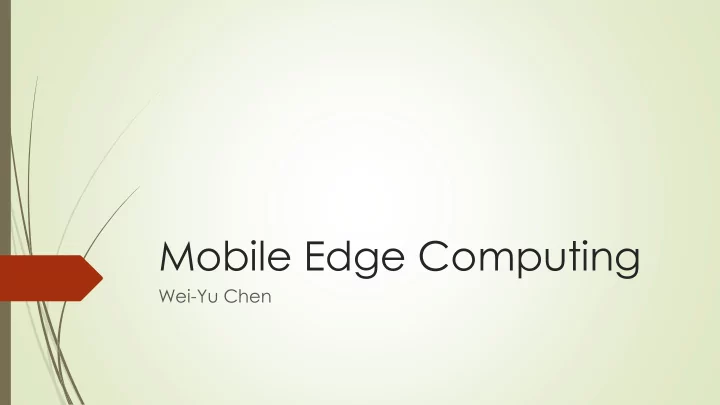

Mobile Edge Computing Wei-Yu Chen
Outline 5G Communication Components Computation Offloading Mobility Management and Service Migration
5G Communication Components Software Defined Network(SDN) Network Function Virtualization(NFV) Mobile Edge Computing(MEC) Centralized control, distributed service
Mobile Edge Computing Defined by ETSI(European Telecommunications Standards Institute) “Mobile edge computing provides an IT service environment and cloud computing capabilities at the edge of the mobile network, within the radio access network (RAN) and in close proximity to mobile subscribers.”
Mobile Cloud Computing Internet Core UE BS Network Cloud Center Provide shared pool on resources Compute, software, storage Amazon EC2, Microsoft Azure Centralized Long distance results in high latency
Mobile Edge Computing Geo-Distributed Cloud System Small local servers, small cells Computing augmented Base Stations Computing resources installed in RAN Fog Computing
Mobile Edge Host Mobile Core UE Edge Internet Network BS Host Computing equipment Computation Offloading Proximity Low latency Resource virtualization Accessed by API on UE, based on SDN and NFV
Mobile Edge Host Mobile Core UE Edge Internet Network BS Host Traffic monitoring Content caching Caching proxy Local information aggregation User location services Small cell, more precise
Three-layer Architecture MEC resides in the layer between the Cloud and the mobile device
Reference Architecture
Computation Offloading None Offloading Local Execution Partial Offloading Full Offloading
Computation Offloading Offloadability of application Knowledge on the amount of data Video and image processing Online interactive games Dependency of offloadable parts Serial VS Parallel
Offloading Decision Execution delay Energy consumption With delay constraint Tradeoff
Allocation of Computing Resource Single MEC Node Multiple MEC Nodes
Mobility Management Limited Mobility Building Stadium Campus Signal Interference to Noise Ratio(SINR)
Handoff Changing connection from one BS to another Service continuity Guarantee QoS
Handoff Hard Handoff Soft Handoff
Service Migration Applications run on VM Migration Cost Migration Gain
Aggregation Point Connection through various communication protocols 3G, LTE, 5G, Wifi Multiple UEs via multiple channels NP hard
Advantages Low latency Extending UE battery lifetime Enable sophisticated applications on UE Provide higher data storage capabilities
Improvements Optimization of mobile resources by hosting compute-intensive applications at the network edge. Pre-processing of large data before sending it to the cloud. Context-aware services with the help of RAN information such as cell load, user location, and allocated bandwidth.
Challenges Resource management – The computing and storage resources in individual MEC platform are expected to be limited. Interoperability – MEC infrastructures owned by different network providers should be able to each other as well. Mobility support – The coverage range of each individual cell is limited in a small cell network. Seamless handoff and migration are necessary.
Applications Health Care Stroke Fall Augmented Reality Content Delivering and Caching Video Streaming Video Analytics Surveillance Camera(face recognition) IoT Smart home Smart City
Recommend
More recommend